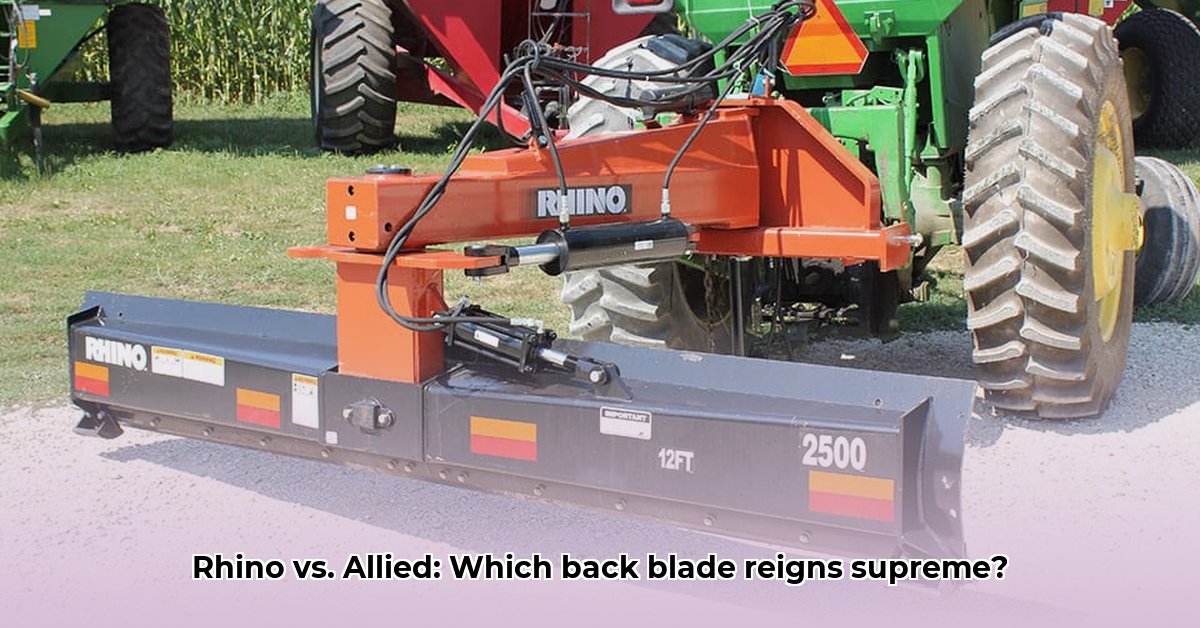
Choosing the right rear blade for your tractor is a crucial decision impacting both productivity and longevity. This comparative review analyzes Rhino and Allied (by Farm King) rear blades, guiding you through the selection process based on your specific needs and tractor specifications. We'll examine key features, highlight strengths and weaknesses, and provide a step-by-step guide to ensure you make an informed purchase. For more detailed specs, check out this helpful resource.
Power and Control: Matching Blade to Tractor
The first consideration is your tractor's horsepower and the level of control desired. Rhino blades, particularly their heavier-duty models (e.g., 2500 and 3500), are typically designed for higher-horsepower tractors and often feature fully hydraulic adjustments. This allows for precise control over angle, offset, and tilt—ideal for large-scale land leveling or shaping. Allied blades, conversely, cater to a wider horsepower range, including lower-powered tractors. Some Allied models are entirely manual, providing a simpler, more affordable option for smaller jobs where precise hydraulic control isn't essential. Do you require pinpoint accuracy for large-scale projects or will a simpler, manual setup suffice for your smaller tasks?
Strength and Durability: Long-Term Investment
Both Rhino and Allied typically utilize high-carbon steel cutting edges. However, Rhino emphasizes precision-formed moldboards, claiming this design reduces wear and tear. Allied often highlights the sheer amount of steel used, suggesting superior overall strength. While detailed material specifications vary by model, a focus on long-term durability is crucial. How will the chosen blade withstand the rigors of your intended applications over many years? Independent user reviews can provide insights into real-world performance.
Design and Features: Adding Value
Subtle design differences can significantly impact performance. Rhino blades frequently incorporate an extended cutting edge, aiming to minimize wear on the main moldboard – a feature less common in Allied models. Furthermore, the availability of accessories like skid shoes (for protection against obstacles) and gauge wheels (for consistent depth control) varies between brands. Carefully review the available accessories to determine which features best suit your needs.
Choosing Your Blade: A Step-by-Step Guide
Follow these steps for a successful purchase:
- Assess Tractor Capabilities: Determine your tractor's horsepower and hydraulic system capacity to ensure compatibility.
- Define Your Tasks: Identify primary uses—land leveling, snow removal, ditch maintenance, etc.—to select appropriate blade size and features.
- Compare Specifications: Analyze both Rhino and Allied blade specifications, focusing on steel thickness, warranty, and additional features.
- Consider Total Cost: Account for initial cost alongside potential repair and replacement expenses over the blade's lifespan.
- Review User Feedback: Seek unbiased online reviews and testimonials from fellow farmers or contractors.
- Consult Dealers: Contact equipment dealers for expert advice, personalized recommendations, and potential demonstrations.
Rhino vs. Allied: A Summary Comparison
| Feature | Rhino | Allied by Farm King |
|---|---|---|
| Horsepower Range | Typically higher horsepower | Wide range, including lower horsepower |
| Hydraulics | Often fully hydraulic in larger models | Hydraulic and manual options available |
| Moldboard Design | Precision-formed, often extended cutting edge | Generally emphasizes robust steel construction |
| Warranty | Varies by model; check manufacturer's website | Varies by model; check manufacturer's website |
| Pricing | Varies by model; check manufacturer's website | Varies by model; check manufacturer's website |
Longevity Considerations: Building a Lasting Investment
Choosing a rear blade is a long-term investment. To maximize its lifespan, focus on these key features:
- Material Quality: High-strength steel is paramount. Investigate the specific steel type and thickness.
- Robust Construction: Sturdy welds, strong kingpins, and a well-designed moldboard are essential for withstanding heavy use.
- Replaceable Cutting Edge: This extends the overall blade life and minimizes replacement costs.
- Hydraulic vs. Manual: Weigh the convenience of hydraulics against the potential maintenance complexities.
Remember, the most effective blade is one perfectly aligned with your specific needs and budget. This review provides a framework for informed decision-making – thorough research and direct comparison remain crucial for a successful purchase.